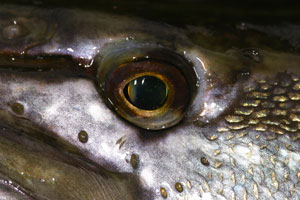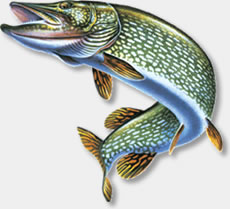Pike (Esox lucius)
Weight: Small fish up to 1lb are caught often by accident with fish weighing between 3lb and 8lb normally providing the average sport for predator anglers. On venues where there’s a constant stream of food fish, pike will grow to 20lb and on venues such as trout stocked reservoirs the predator will reach 30lb-plus with a few growing over 40lb.
British Record: 46lb 13oz from Llandegfedd Reservoir in Gwent, Wales to R Lewis, 1992.
Length: On average fish grow to a length between 40cm and 100cm. However, fish have been caught measuring 130cm.
Age: Can live for up to 15 years in the wild.
Preferred habitat: Pike are able to survive in a variety of different waters from canals and drains to village ponds, rivers and streams. They can survive in lightly polluted venues and in water with low oxygen levels. The pike is completely at home in low temperatures, but high heat, above 29 degrees Celsius, can prove fatal. Smaller fish are commonly found close to features in shallow, sheltered areas, but the larger adults prefer to patrol deep-water areas.
Feeding: The pike is a carnivore and feeds on other fish including its own kind. During the spring pike have been known to feed on frogs and young wild fowl including ducks, coots and moorhens.
Maturity: Both males and females mature in two to three years.
Spawning: Although fish have been seen mating in mild winters, March is the time for spawning where the fish seek out shallow areas where there’s plenty of weed/reed growth. The bigger females then lay their sticky eggs on the stems that are fertilised by three or more smaller males. The eggs take between 10 and 15 days to hatch and in the first few months grow very fast, feeding off the abundance of life in and around the margins.
Natural predators: Pike
Identification
Colouring
The wonderful patterns displayed by a mature pike make them unmistakable, with an olive green/brown back and flanks beautifully marked with flecked markings of a lighter golden green. The underbelly can be almost white, with little or no marking. Superbly sensitive glands along the lateral line and on the head help the pike sense movement from prey fish even before they see them.
Mouth
The pike has a large, long, flattened stout where the lower jaw, which is angled backwards, protrudes beyond the upper. It’s the lower jaw that also boasts a series of large, needle-sharp teeth with the upper filled with a dense number of smaller teeth in the roof.
 |
Eyes
Being a predator, the pike has two large golden-coloured eyes set facing forwards to give it binocular vision, so that the fish can gauge the distance to its prey.
Pectoral Fin
Brown/orange in colour with black flecking, the fin is long and convex in shape with thick rays.
Dorsal Fin
To enable the pike to accelerate quickly as it strikes at its prey the large, convex, black-speckled fin is set close to the tail.
Pelvic Fin
These are also convex in shape with thick rays and are predominately orange/brown in colour with black marks.
Anal Fin
This fin is located below the dorsal fin and is almost the same size and shape as the upper fin. It’s this configuration with both the anal and dorsal fin close to the tail that gives the pike its awesome power through the water.
Tail/Caudal Fin
This big spade of a tail has the same colouring and marking as the rest of the fish’s fins. The concave fin is the final cog in the powerful engine that propels the predator like a missile, as it strikes on its unsuspecting prey.
The Life Cycle
Perfect Predator
Pike are brilliantly put-together predators with a body design that appears not to have changed very much for at least 60 million years. Their long, slender shape cuts through the water with ease, they are cunningly camouflaged and the head end is full of detection systems to locate prey. Their large eyes are set close together and high on the head to give fantastic, detailed vision; they even have special filters to reduce glare in bright conditions!
Good Vibrations
The lateral line system that runs along the side of the body, used to sense vibrations in the water from possible prey, extends right onto the head in the form of pores (or pits) visible under the jaw and across much of the rest of the head. This means that a swimming fish (or retrieved lure!) makes vibrations in the water that pike can feel even if they cannot see it. Partially blind pike can actually survive quite well using these vibration sensors to find food, rather than good vision.
Sense Of Smell
The nostrils on the pike’s head are large and undoubtedly provide the fish with a strong sense of smell for scavenging for dead fish lying on the bottom, especially important for older, bigger pike. More bloody or oily deadbaits (like lamprey or mackerel) give really strong scent trails for hungry pike to follow.
Strike One!
When prey is located, pike can strike if they need to with astonishing speed – American studies have shown small jacks reaching over 10 miles per hour in striking for prey. That may not sound that fast until you realise the fish is travelling the equivalent of ten times its own length every second! However, because of the arrangement of their muscles to create this massive acceleration, pike can maintain fast swimming for just a very short time (much less than one second!) so undoubtedly playing pike can exhaust them and care of your catch becomes even more important! You need to ensure that fish are unhooked with great care and returned gently to the water, supported until they are ready to swim away.
Sharp End
The pike’s mouth is incredibly well equipped with teeth for dealing with prey. Large teeth around the jaws ensure that anything grabbed is held tight and the many smaller teeth on the tongue and the roof of the mouth make sure that as prey is heading down the throat, its chances of escape are very small indeed!
On The Menu
Pike eat whatever they can feasibly swallow. Usually, they prefer fish 10-15% of their own size but will take prey nearly half their own weight! There are indeed many extreme examples of pike eating fish of their own size, sometimes choking in the attempt since their backward-facing teeth do not allow them easily to spit out food items. But they do not start out in life eating other fish – until they are around 3cm (1½ inches long) they eat eye-catching aquatic invertebrates like water fleas, mayfly nymphs and water boatmen. Once they switch to a largely-fish diet, growth can be very quick – a one-year-old pike can be 30cm (12 inches) long, a three-year-old as much as 45-60cm (15–24 inches) long and a five-year-old 70-80 cm (27-32 inches) long.
Cannibals
Pike seem keen on eating other pike and may do a good job of controlling numbers of their own kind. Cannibalism might account for up to half the death rate in pike up to the age of three years. They rarely live beyond 15 years of age (around 30lb in weight) but really exceptional fish are thought to have lived to over 20 years and 70lb in weight! Just how big pike can grow has been the subject of entire books and much legend! Probably, however, angling pressure means that the days of really massive pike are gone.
Spawning Time
Pike spawn between February and May, as water temperatures rise beyond 4-11ºC. They choose weedy shallows where the water warms up and any flow is minimal – in rivers they migrate into side channels or backwaters. They may make long migrations to find good spawning sites, males arriving first to await the bigger females. Two or more males will then chase and jostle a female, fertilising her eggs before they stick to water weeds and tree roots. Some 10-30 days later, the tiny pike fry hatch and immediately attach to the weed with a sticky pad on their heads. About a week later, these 6-8mm long pike start to swim freely, feeding on microscopic invertebrates. The vast bulk of these youngsters die from starvation or predation, eaten by other pike or a host of larger invertebrates.
Care For Your Catch
Pike are incredibly delicate fish, especially when they grow big and old. They suffer badly from shortage of oxygen and exhaustion after capture and deserve our care. What they do not deserve is the age-old habit of ‘chinning’ for photography where the angler puts two or more fingers of one hand inside the gill area to support the pike’s head whilst the other hand holds the lower body of the fish. Anglers put their hands inside a pike’s gills because they can. The fish is made that way with big, finger-size openings. However, specialist anglers would not dream of doing the same to any other species, so why do it to pike? You can cause so much damage to gills and restrict major blood vessels flowing from the heart into the gills in the ‘chin’ area. It is probably okay to use a couple of fingers into the gill area to open the mouth for unhooking when a fish is on a mat and under control, but in my opinion it is not okay to lift a fish from the water or hold it for a photograph with two fingers shoved into its most sensitive areas. We should not be surprised that pike stocks cannot take much angler pressure when such practices are repeatedly publicised as the ‘right’ way!






